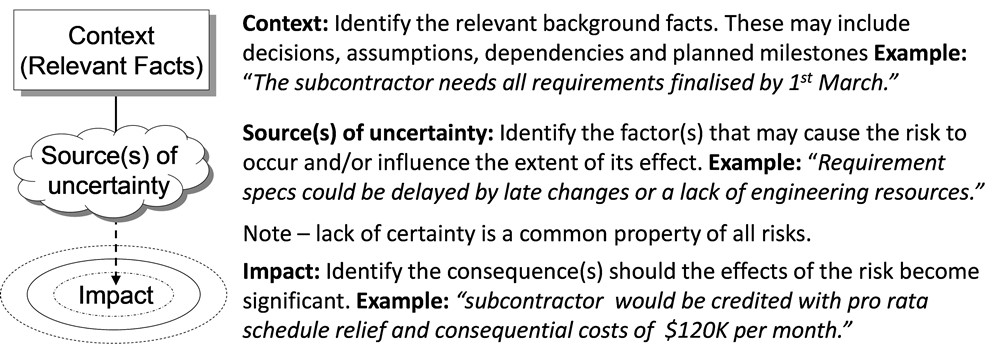Practical Project Risk Management
SERIES ARTICLE
By Martin Hopkinson
United Kingdom
Purpose
Articulate risks in a way that can be understood, analysed and acted upon
Recommended Approach
There are a number of risk description techniques. The three-parts approach recommended below supports both qualitative and quantitative risk analysis techniques and can be linked to risk modelling. The given example is simple description of a risk event. However the approach is sufficiently flexible to describe more complex situations and is not confined to risk events. For example it can be used to describe opportunities, variability risks and ambiguity risks.

Risk Titles: A headline approach is useful e.g. “Late Finalisation of Subcontract Specifications”
Risk Registers
Many risk registers have three fields to record risk descriptions, although they often use different field titles. You may find that the titles they use are equivalent e.g. using the word consequence or effects instead of impact. If not, it may help if the field titles can be changed.
Link with Risk Modelling
Risk models are based on the same combination of three parts as the recommended risk description approach.
Context (relevant facts): model scope and structure e.g. activity breakdown and dependencies.
Source(s) of uncertainty: the risk model’s inputs that simulate the implications of uncertainty e.g. probability density functions, risk estimates and probabilistic or conditional events.
Impact: the risk model output(s) that are designed to quantify impact e.g. project cost risk.
More…
To read entire article, click here
Editor’s note: This series of articles is by Martin Hopkinson, author of the books “The Project Risk Maturity Model” and “Net Present Value and Risk Modelling for Projects” and contributing author for Association for Project Management (APM) guides such as Directing Change and Sponsoring Change. These articles are based on a set of short risk management guides previously available on his company website, now retired. For an Introduction and context for this series, click here. Learn more about Martin Hopkinson in his author profile below.
How to cite this paper: Hopkinson, M. (2022). Risk Descriptions: A brief guide, Practical Project Risk Management series, PM World Journal, Vol. XI, Issue IV, April. Available online at https://pmworldlibrary.net/wp-content/uploads/2022/04/pmwj116-Apr2022-Hopkinson-risk-descriptions-practical-risk-management-2.pdf
About the Author

Martin Hopkinson
United Kingdom
![]()
Martin Hopkinson, recently retired as the Director of Risk Management Capability Limited in the UK, and has 30 years’ experience as a project manager and project risk management consultant. His experience has been gained across a wide variety of industries and engineering disciplines and includes multibillion-pound projects and programmes. He was the lead author on Tools and Techniques for the Association for Project Management’s (APM) guide to risk management (The PRAM Guide) and led the group that produced the APM guide Prioritising Project Risks.
Martin’s first book, The Project Risk Maturity Model, concerns the risk management process. His contributions to Association for Project Management (APM) guides such as Directing Change and Sponsoring Change reflect his belief in the importance of project governance and business case development.
In his second book Net Present Value and Risk Modelling for Projects he brought these subjects together by showing how NPV and risk modelling techniques can be used to optimise projects and support project approval decisions. To learn more about the book, click here.
To view other works by Martin Hopkinson, visit his author showcase in the PM World Library at https://pmworldlibrary.net/authors/martin-hopkinson/









